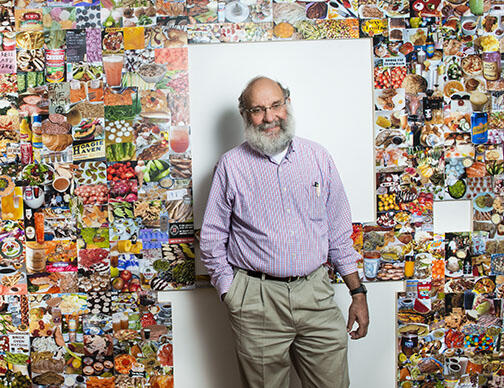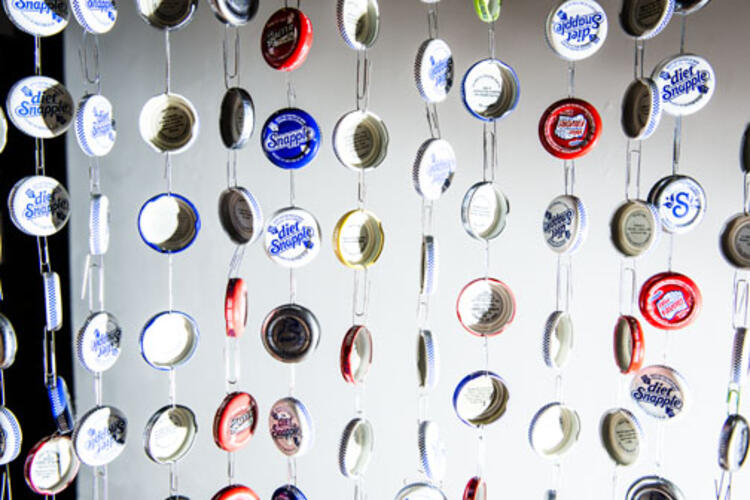Visitors to the Lewis Center for the Arts this fall entered a series of rooms and found the kind of stuff one might have in an old shoebox at the back of the closet. There were kitschy travel souvenirs and obsolete computer keyboards; store coupons and train tickets strung together by paper clips; old license plates from several states; and a wall of 1980s-era postcards. The sign over the entrance said “Lucas Gallery” — but was this really art?
That’s the question posed by the graduate course “Contemporary Art and the Amateur,” taught by Joe Scanlan, director of the Program in Visual Arts. In this case, the amateur is Dean of the Faculty David Dobkin, a 65-year-old computer science professor with a mischievous smile peeking from his salt-and-pepper beard. Dobkin has spent the last 35 years collecting and arranging the hundreds of items in the gallery — and more at his home. His collections sprawl from snow globes (he has more than 800) to Popsicle sticks, from Snapple-bottle lids and the fake credit cards that come in junk mail to old CDs and paper tubes. He has 700 pounds of pennies, sorted by year and mint and stored in custom-made acrylic towers; and 100,000 digital photographs of Curb Your Dog signs, restaurant menus, phone booths, and other objects.
From an early age, Dobkin was “possessed by a compulsion to collect and organize objects,” he says. He never has thought of himself as an artist — he has a doctorate in applied mathematics from Harvard and never has taken an art class — and was “half-amused and half-terrified” by having his work debut in a solo show in an 1,100-square-foot gallery space, usually used for student exhibitions. “I’m not sure where I am on the eccentric-to-artist” trajectory, says Dobkin, who began saving items such as water-bottle caps “because they just looked too good to throw away.” One of his first projects was a set of curtains he made by stringing Dannon yogurt lids together with paper clips.
For Scanlan, who hatched the idea of mounting the exhibition after seeing the pennies in Dobkin’s office, the artistry of the dean’s work is in “noticing potential in useless or tacky things. He rehabilitates them. It’s an appreciation of ephemera and all the things that pass us by.” The students in his class will be exploring how the concept of the amateur artist has influenced contemporary art.
Scanlan says Dobkin’s work is art because it “moves you to feel or think.” He adds, “I think David’s work is really joyful. You can’t walk into the gallery and not get a smile on your face immediately, but I think there’s a dark side to it. There’s the joy, but also a sort of ‘not to worry’ about the fact that we’re all engaged in somewhat hopeless endeavors.”
Contemporary art has questioned the concept that technical skill or training is required to be an artist, Scanlan says, and values the open minds of amateurs who aren’t trained and aren’t getting paid. “When people don’t know how to do something, it can sometimes create amazing results — results which aren’t possible if you know too much,” he says. And the art world has embraced the obsessive collector — the person who, like Dobkin, saves every bottle cap or paper clip that passes through his hands, according to Scanlan. The professor’s work fits into a current fascination with “anti-aesthetics,” in which artists devise systems for making art that defy traditional notions of composition and taste. One of Dobkin’s is to save and display every penny that comes into his possession.
Dobkin’s work also can be viewed in the tradition of artists like Marcel Duchamp, who famously put a urinal on a pedestal in 1917 and named it “Fountain.” Duchamp helped remake the boundaries of what is defined as art — asking “what exactly made an artwork ‘art’ as opposed to mere stuff?” says Elena Filipovic *97, a Duchamp scholar.
Intellectual debate aside, Dobkin hopes that those who viewed his exhibition, which ran Sept. 19 through Oct. 4, appreciated “how individual things, none of which is that interesting by itself, come together and tell a story. I don’t want to tell them what the story is, largely because I don’t know. But I want them to leave with a story.”














No responses yet